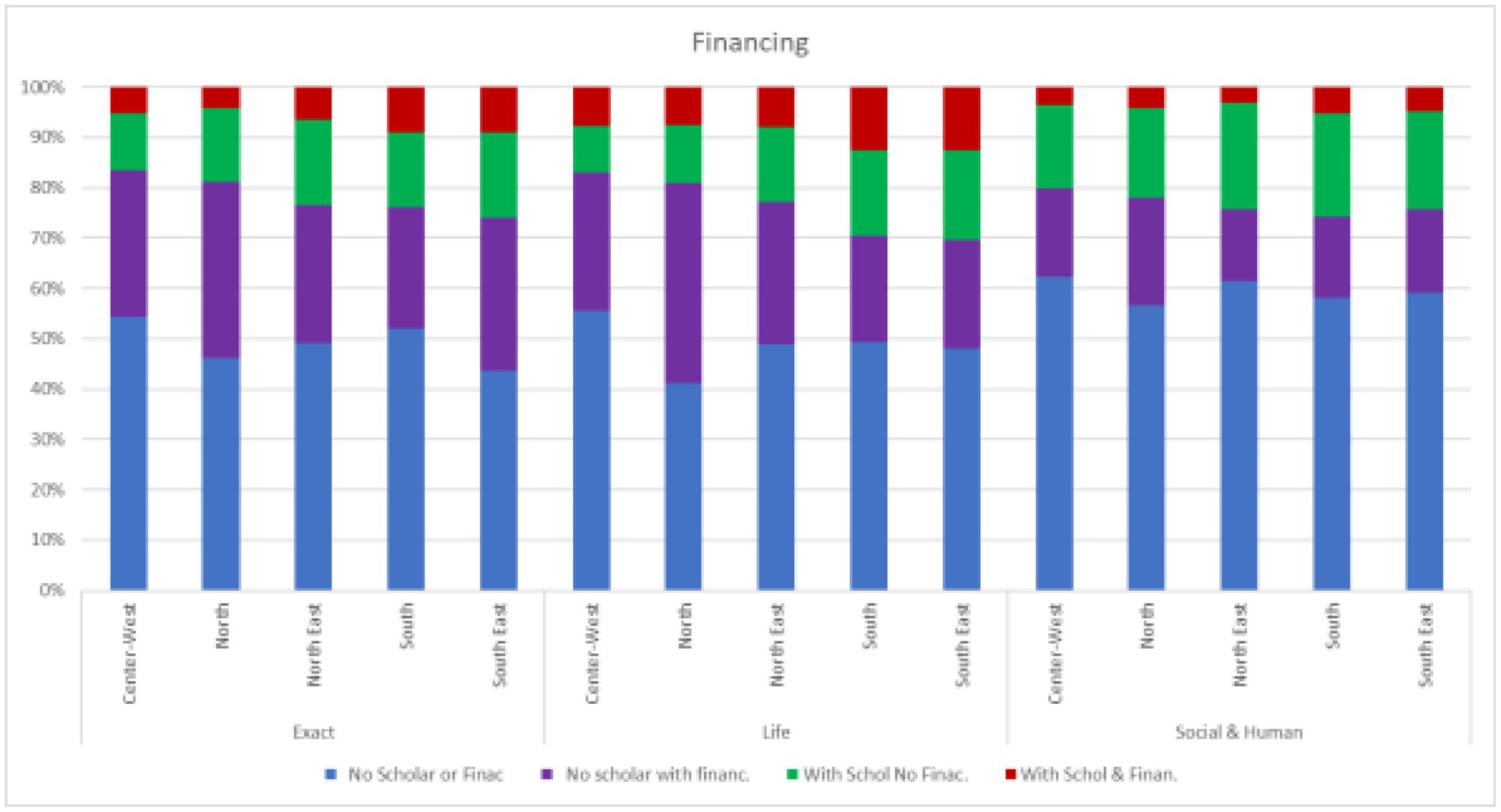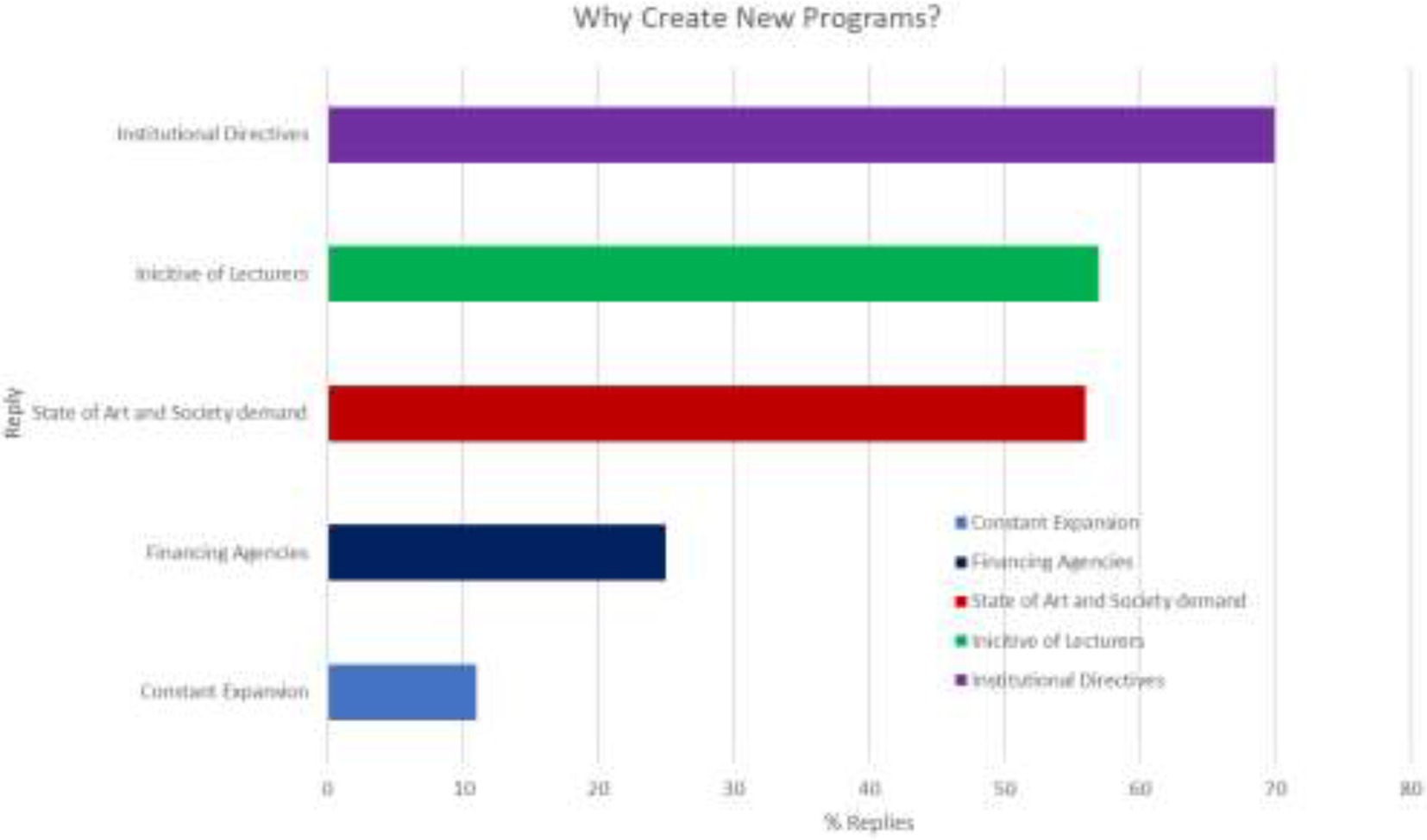Considerations for continued expansion of the Brazilian post-graduate system
- 1Universidade de Brasília, Campus Darcy Ribeiro, Brasília, DF, Brazil
- 2Universidade de São Paulo, Butantã, São Paulo, SP, Brazil
- 3Universidade Federal de Uberlândia, Uberlândia, MG, Brazil
- 4Departamento de Física, Universidade Federal de Ceará, Fortaleza, Brazil
- 5Universidade Federal de Rio de Janeiro, Rio de Janeiro, RJ, Brazil
- 6Universidade Federal de Goiás, Campus Samambaia, Goiânia, Goiás, Brazil
- 7Universidade Federal de Paraíba, João Pessoa, PB, Brazil
- 8Universidade Federal de Pernambuco, Recife, PE, Brazil
- 9Pontifícia Universidade Católica do Rio Grande do Sul, Porto Alegre, RS, Brazil
- 10Universidade de Caxias do Sul, Campus Sede, Caxias do Sul, RS, Brazil
- 11Universidade Federal de Acre, Rio Branco, AC, Brazil
- 12Universidade Estadual do Sudoeste da Bahia, Vitória da Conquista, BA, Brazil
- 13Faculdade São Leopoldo Mandic, Campinas, SP, Brazil
The number of programs and students in the Brazilian postgraduate system has doubled in the last 10 years. This has implications for the quality and financing of these programs as well as for the development of the regions where they are set. This study aims to investigate the reasons and limitations for the continued expansion of the Brazilian postgraduate system. Data (2011 to 2020) for this study came from: (i) the “Sucupira” postgraduate database from the Coordenação de Aperfeiçoamento de Pessoal de Nível Superior (CAPES), (ii) Instituto Nacional de Estudos e Pesquisas Educacionais Anísio Teixeira (INEP), (iii) Brazilian Institute of Geography and Statistics (IBGE), (iv) InCites® and Web of Science data, and (v) questionnaire and meetings with the deans for Higher Education Institutions (HEIs) in Brazil. Data analyses included regression over time, frequency chi-square, and correspondence analyses. Different types of institutions in different regions showed varying opinions, with higher expectations for expansion in smaller, newer institutions, especially private ones. While the HEIs in the Northern region believe that the master’s degree is to correct undergraduate flaws, the HEIs in the South and Central regions and the community believe that the master’s degree should develop professional skills. In contrast, the larger HEIs with older postgraduate programs in all regions believe in direct doctorate strategy. The reasons for creating new post-graduate programs involved following the institution’s general guidelines for private and community HEIs and granting the lecturers’ wishes or constant expansion depending on region, North, Northeast, and Central regions, as well as for creating medium-sized state universities. State-of-the-art research or the interests of society were prevalent for the largest and oldest HEIs. Continued expansion of the Brazilian postgraduate system needs to take into account factors including the demand for the program, regionalization, the quality of the programs, the means of funding, and the student vacancies existing in programs with high grades, among other challenges.
Introduction
The expansion of the Brazilian Post-graduate system (SNPG) has been a priority in all National Post-Graduate Plans (PNPG) to date, especially in the last plan effective from 2011 to 2020. The formation of the Brazilian national postgraduate system was the most successful project in higher education since the university reform of 1968. The numbers are remarkable and growing each year (Cirani et al., 2015; McManus and Baeta Neves, 2021a), thus reaching over 4,600 programs with over 7,000 courses (so-called professional and academic masters and doctorates), reflecting an increase of over 100% in 10 years. Results confirm the success of public policies marked by an unusual continuity and clarity of purpose for national standards (Baeta Neves, 2020). Masayuki (2011) recognizes the contribution of postgraduate education towards forming highly-skilled workers for innovation, whereby expansion of postgraduate education may contribute to narrowing the wage gap between men and women and increasing labor force participation.
In some countries, postgraduate studies have expanded to become a core part of a mass higher education system (Wakeling, 2010). Motivations to follow postgraduate education include gender, age, and family socioeconomic status (Jung and Lee, 2019) as well as the originating higher education institution (HEI), with Wright and Horta (2018) showing that the expansion of the undergraduate system leads to a demand for postgraduate training to compete better in the job market.
The expansion of the federal undergraduate system in Brazil (Sales et al., 2019) and the expansion of the private sector (Balbachevsky et al., 2019) means that there is an increased number of students, even though there may be a correlated issue on quality that needs to be addressed (Almeida et al., 2020; Costa, 2022). In Ethiopia, Akalu (2014) highlighted that higher education expansion has placed undue pressure on quality enhancement and autonomy of universities. As government pressures for more expansion, universities struggle with dwindling per-student budgetary allocations, shortage of qualified staff, inadequate supply of much-needed inputs, and the erosion of their autonomy. Fatemi and Saito (2019) show that cultural diversity can cause challenges to postgraduate students, especially those lacking previous training in academic research, taking into account the increase in the number of students from private institutions. In turn, this can increase dropout rates (Bicalho de Souza et al., 2021).
While higher education expansion remains an important goal, a reasonable balance should be struck between the ideological aspects of expansion and the practical realities of limited resources, heightened concerns about the quality of student learning, adequate infrastructure for research, and universities’ autonomy. After this long period focusing on expansion, we must now address issues related to the consolidation and quality of the existing programs. This has an impact on the postgraduate system, as the Higher Education Institutions (HEIs) that increased the number of professors and students, also increased the number of postgraduate courses as these institutions contracted more lecturers with doctorate degrees (Paula and Almeida, 2020). Postgraduate programs go through an initial evaluation for implantation, which is then reviewed every four years. Research shows that the quality of research in these HEIs is lower than in the larger more traditional institutions (McManus et al., 2022). Souza et al. (2020) highlight the main challenges within postgraduate programs including working conditions, deficient infrastructure, high bureaucracy, and work overload. They also stated the challenges of researchers’ low interaction with each other and the demands of society, the lack of commitment and qualification of the researchers, and the low relevance of the research developed. This leads to the question of the need for continued expansion without appropriate policy reforms.
Lu et al. (2013) also noted a reduction in quality with increased postgraduate enrolment in China. Because of the expansion, the number of graduate students has increased. However, the investment rate in postgraduate education resources is not proportional to the growth rate of postgraduate students (Tian et al., 2019). Employment perspectives must also be taken into account (Carpenter, 2019). Colombo and de Castro Garcia (2021) show that employees with postgraduate education can increase the chance of university-business collaboration and therefore provide employment opportunities for upcoming students. Finance for research and postgraduate studies has been decreasing in Brazil in recent years (McManus et al., 2022). Schwartzman (2022) states that it makes no sense to create and maintain research centers and doctoral programs without quality and resources for equipment, technical support staff, and low student recruitment.
Thus, the goal of this paper was to look at the past expansion of the Brazilian postgraduate system and evaluate the possibilities and limitations for future (continued) expansion using data from public platforms and the perception of postgraduate deans of the HEIs.
Materials and methods
Data (2011 to 2020) for this study came from five main sources: (i) the “Sucupira” postgraduate database from the Coordenação de Aperfeiçoamento de Pessoal de Nível Superior (CAPES) including data on the postgraduate programs, (ii) Instituto Nacional de Estudos e Pesquisas Educacionais Anísio Teixeira (INEP) for data on the overall education system in Brazil, (iii) Brazilian Institute of Geography and Statistics (IBGE) for population and number of people with higher degrees by State, (iv) InCites® from Clarivate Analytics based on Web of Science data for scientific production, and (v) questionnaires and meetings with the deans for postgraduate education in Brazil.
The Sucupira database (CAPES) included the number of students enrolled and the number of those who received the degree each year, the number of lecturers, the area of knowledge of the program, the postgraduate start date, and the region of the country. CAPES defines the area of knowledge of the program as Agrarian, Biological, Health, Exact and Earth, Engineering, Human and Applied Social Sciences, Literature, and Letters and Arts. From this database, we also acquired information on the program grade (rated from 1 to 7 on a four-year basis). We calculated the number of students per lecturer and dropout rate, and changes in these parameters since 2016, calculating odds ratios by area of knowledge, region of the Higher Education Institution (HEI), type of program [masters (professional or academic) or doctorate], age of the student, and type of institution. Dropout for 2020 was not included given the changes due to the COVID-19 pandemic. This database also included sources of postgraduate project financing, lecturer mobility, as well as student expectations (business, teaching, research, not informed, others, just research, or autonomous professional) depending on their current financial status (retired, scholarship holder, working, collaborator, not informed, or public servant). The age of the student at first matriculation was also available.
Data from the INEP database included the region of the country (North – N, Northeast – NE, South – S, Southeast – SE, or Central-West – CW) and type of Higher Education Institution (HEI; public – federal university, federal institutes of education, science and technology, or research institutes linked to ministries), state, private – for-profit or not, and community institutions. These were also classified according to the age of their postgraduate programs [before 1990 classified as 1980, 1990–1999 (1990), 2000–2009 (2000), 2010 and after (2010)], and the size of their postgraduate system [large (greater than 4,500), medium (1,500 to 4,500), and small (less than 1,500)].
IBGE data included population number and the number of people with higher degrees by state of the federation. IBGE data was used to calculate the number of students, professors, and student professors by state population and population with higher degrees. These data were then used to draw maps in Excel®.
From Incites® we used the number of documents, their impact factor, the percentage of international collaboration, and the percentage of corresponding authors by state. Percentage changes in these indicators were calculated from 2011 to 2020 as:
A total of 264 questionnaires were sent to the National Forum for Deans of Research and Postgraduate Studies (FOPROP) members. Questions included why new master’s and doctoral programs need to be created, who determines the creation of new programs, if the system should continue expanding, and the reasons for this expansion.
Statistical analyses included logistic regression for binomial (0/1) answers along with frequency chi-square analysis and the calculation of odds ratios. Correspondence analyses were used for multiple-choice replies. Correlation and regression analysis were used to evaluate the effect of regional growth in the number of programs on program grades. The INEP and CAPES data were used as independent variables in these analyses, including the region, type, size, and age of the institution. As few federal public research institutes replied to the questionnaire (4), the data for these were joined with federal universities. All analyses were carried out in SAS (Statistical Analysis System Institute, Cary, North Carolina, v9.4).
Results
Current state and recent changes in the Brazilian postgraduate system
In June 2022 there were 4,604 programs registered in the postgraduate system.1 This reflects an increase in all regions of the country but especially in the North and Central-West (Table 1).

Table 1. Number of postgraduate programs by region in 2010, 2017, and 2022 and percentage increase from 2010 to 2022.
In recent years there has been an expansion in the number of courses (ranging from 95 to 385% in different states) in less developed regions (Figure 1A) of the country (mainly the North and Central-West). This quantitative expansion tends to be accompanied by a decrease in the grade (Figure 1B) in the same regions (−29% in Amapa, −14% in Maranhão, −12% in Acre, and − 15% in Rondônia) as new programs tend to have a poorer grade. Espirito Santo and Sergipe were the states with the most improvement in grade (11 and 9%, respectively). As most programs are created with a lower grade (a minimum of 3 for masters and 4 for doctorates) this leads to a decrease in the overall grades by regions, especially in regions with few programs that are growing rapidly. The correlation between the number of new courses and grade is −0.81 and the regression equation is percentage change in grade = −0.16*%growth-1.804 (R2 = 0.66). Nevertheless, the overall number of programs with higher grades in these regions increased.
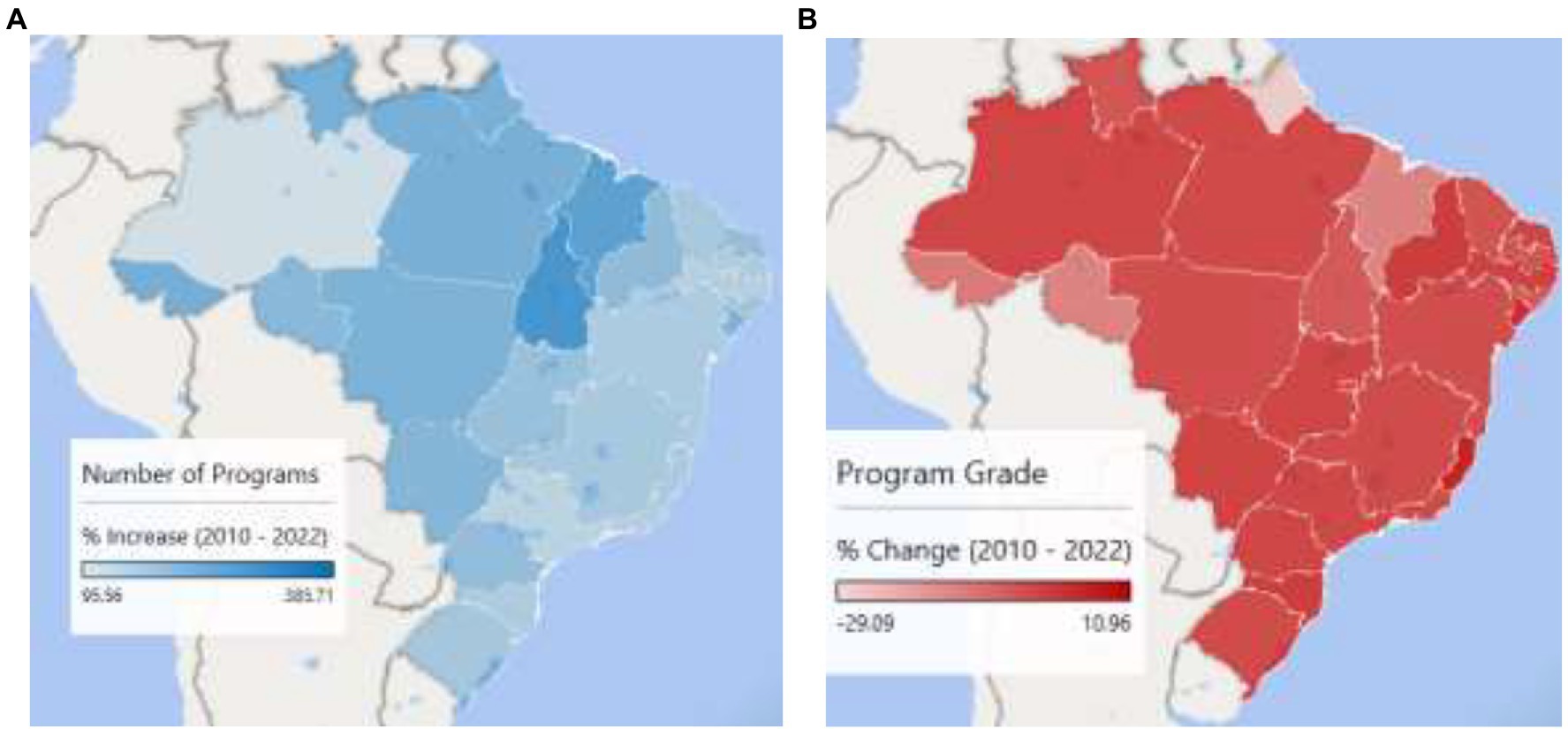
Figure 1. Changes in the number of postgraduate programs (A) and their respective grade (B) from 2010 to 2022 (Sucupira database).
Programs in the Central-West, Northeast, and especially the Northern Regions have more students in programs with lower grades (Supplementary Figure 1), so greater attention to the qualification of programs in these regions should be a priority in a new National Postgraduate Plan (PNPG) which has been planned to cover 2021–2030 period. While around 70% of students in the Central-west and Northeastern regions are in Programs 3 or 4 (with 80% in the North), this is around 45–50% in the South and South-eastern regions (p < 0.05). Grades also varied by area of knowledge with biological sciences ( ) having significantly higher grades (p < 0.05) than other areas and engineering having the lowest . Odds ratios for program grades vary by region, area of knowledge, and type of institution (Table 2).
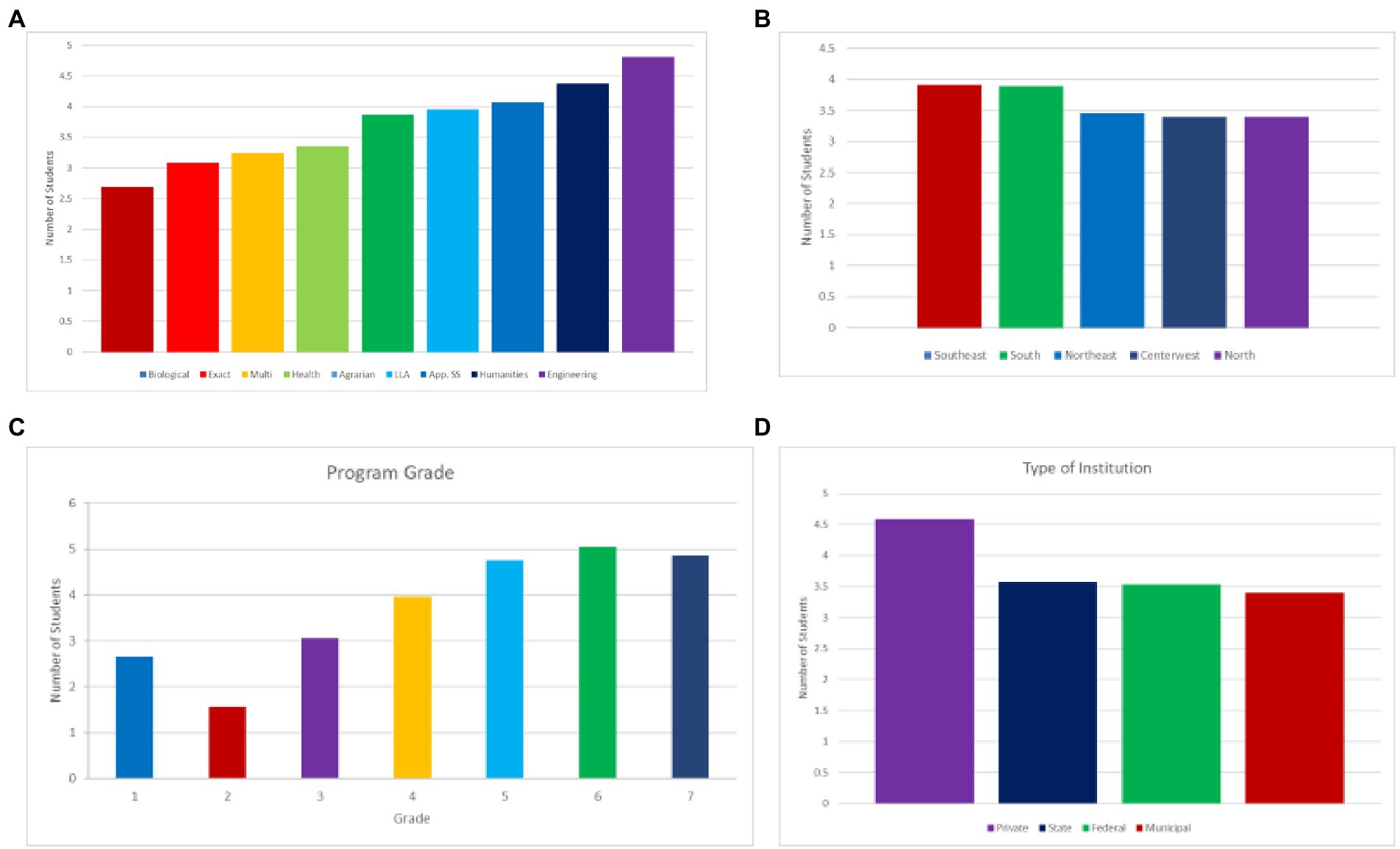
Figure 2. Number of students enrolled per professor (A) by area of knowledge, (B) by region, (C) by program grade, and (D) by type of institution.
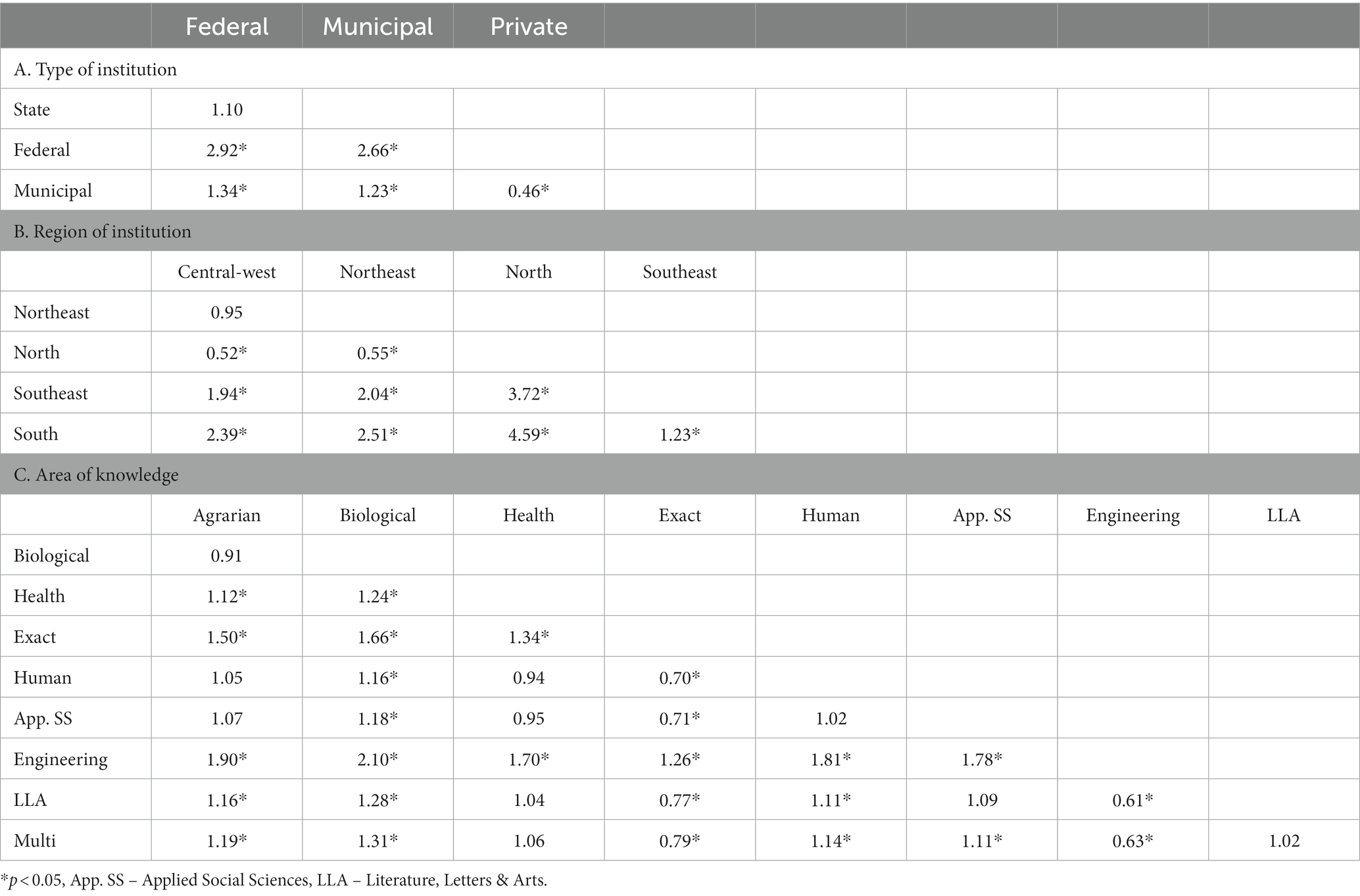
Table 2. Odds ratios for grade (5 or greater vs. 3 or 4) comparison between (A) type, (B) regions of the institution, and (C) area of the program.
The distribution of students by region is 7.53% in Central-West, 19.27% in the Northeast, 5.48% in the North, 47.27% in the Southeast, and 20.45% in the South. The distribution of graduate students and professors in general, per inhabitant and per person with higher education (Supplementary Figure 2) shows that some N and NE states have similar densities compared to those in the S and SE.
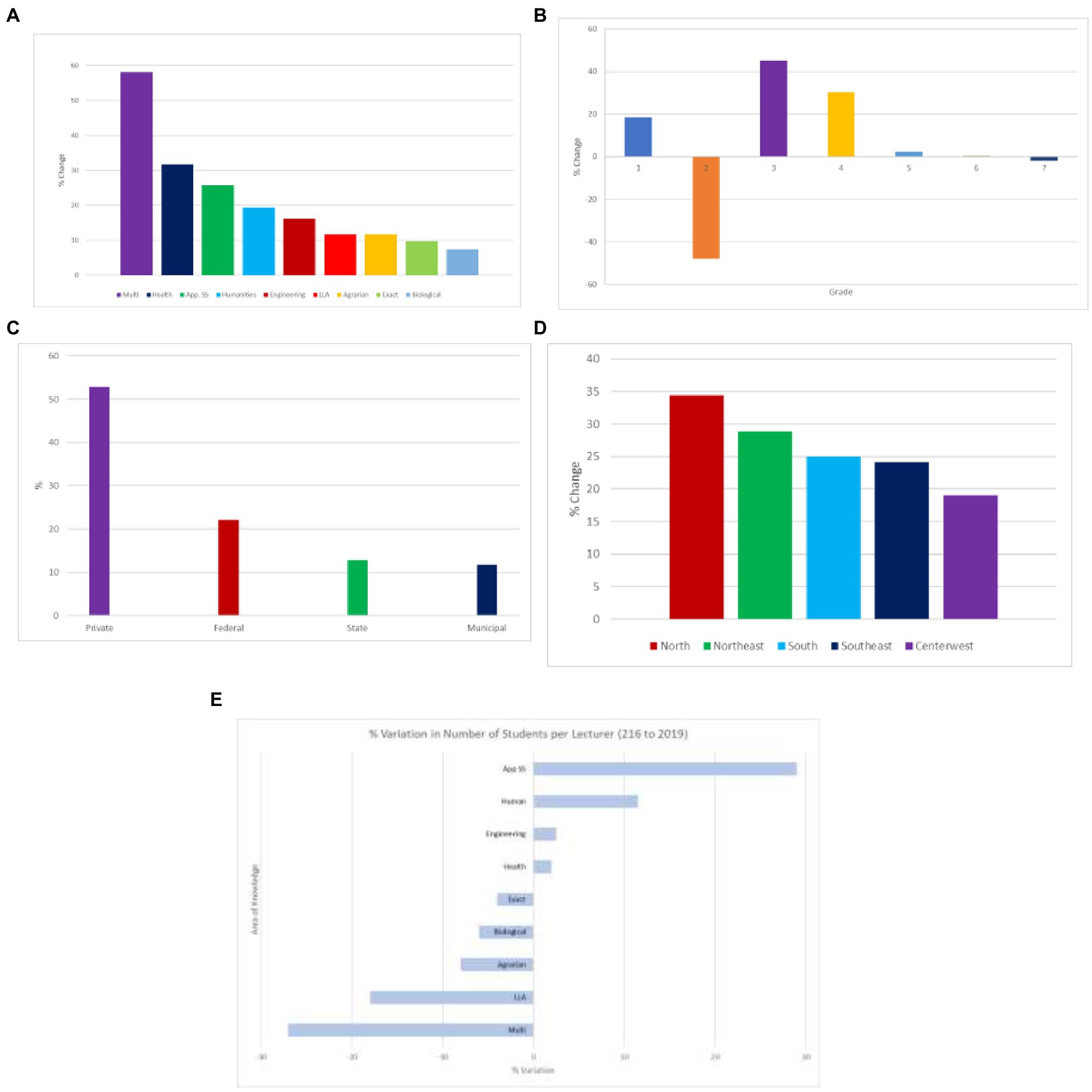
Figure 3. Changes in the number of students per professor (2016–2019) by (A) area of knowledge, (B) program grade, (C) type of institution, (D) region, and (E) percentage change.
Looking at the number of students per program and per professor (Table 3), there is a move away from courses with higher scores in the South and Southwest towards those with lower scores, especially in the North and Northeast (Supplementary Figure 1). Some differences were seen in the Humanities in the Central-west and North where there tended to be growth overall. There was growth in multidisciplinary sciences in the Northeast.
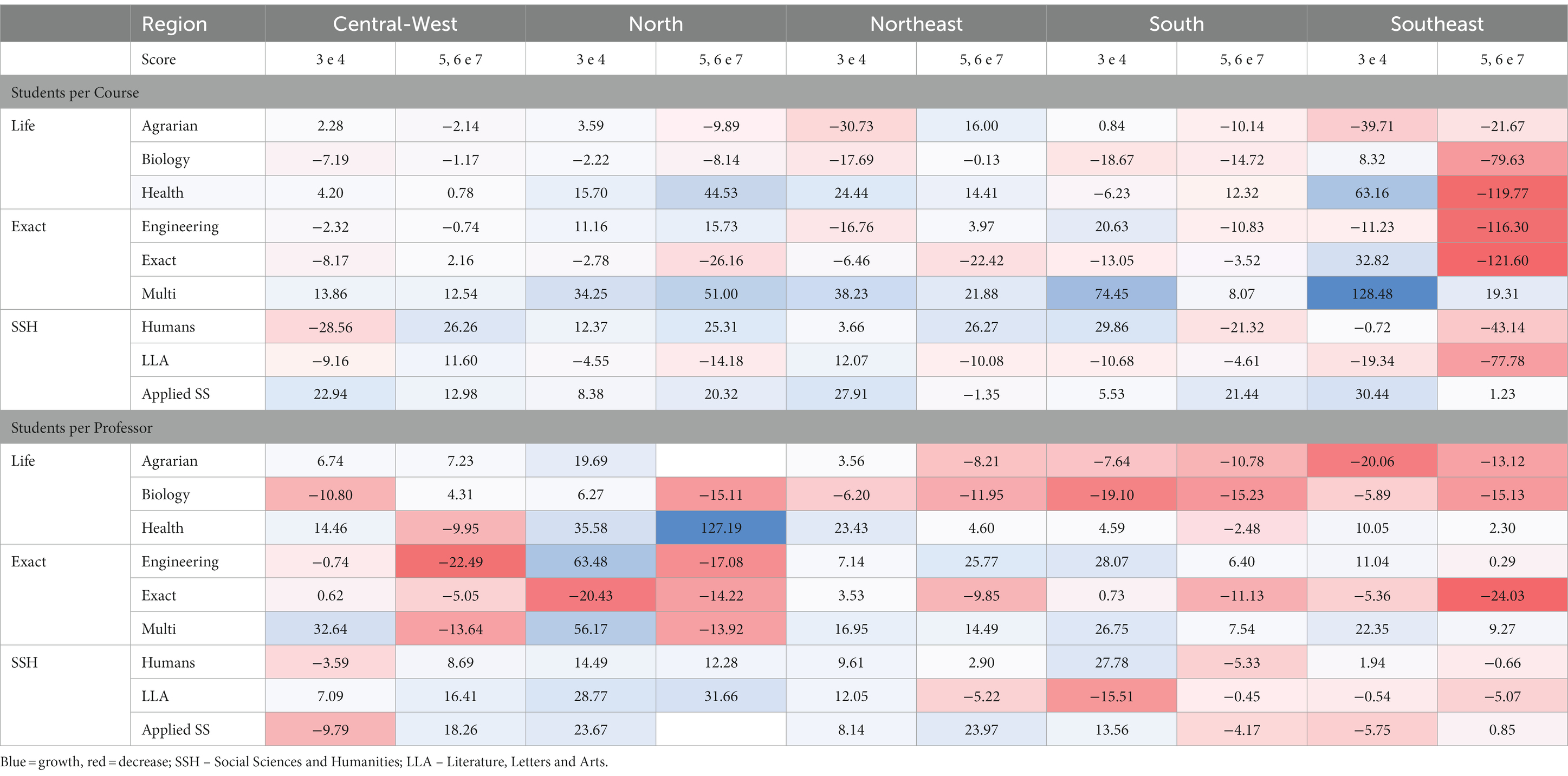
Table 3. Changes in the number of students and students/professor ratio by region and area of knowledge (2013–2020).
There is a higher number of students per professor in engineering and a lower number in biological sciences (Figure 2A), with an increase in the number until the grade 5 programs (Figure 2C) and then stabilization (grades 5 to 7). There are more students per professor (approximately 3.9 per professor) in the South and Southeast regions (Figure 2B), especially in private HEIs (Figure 2D).
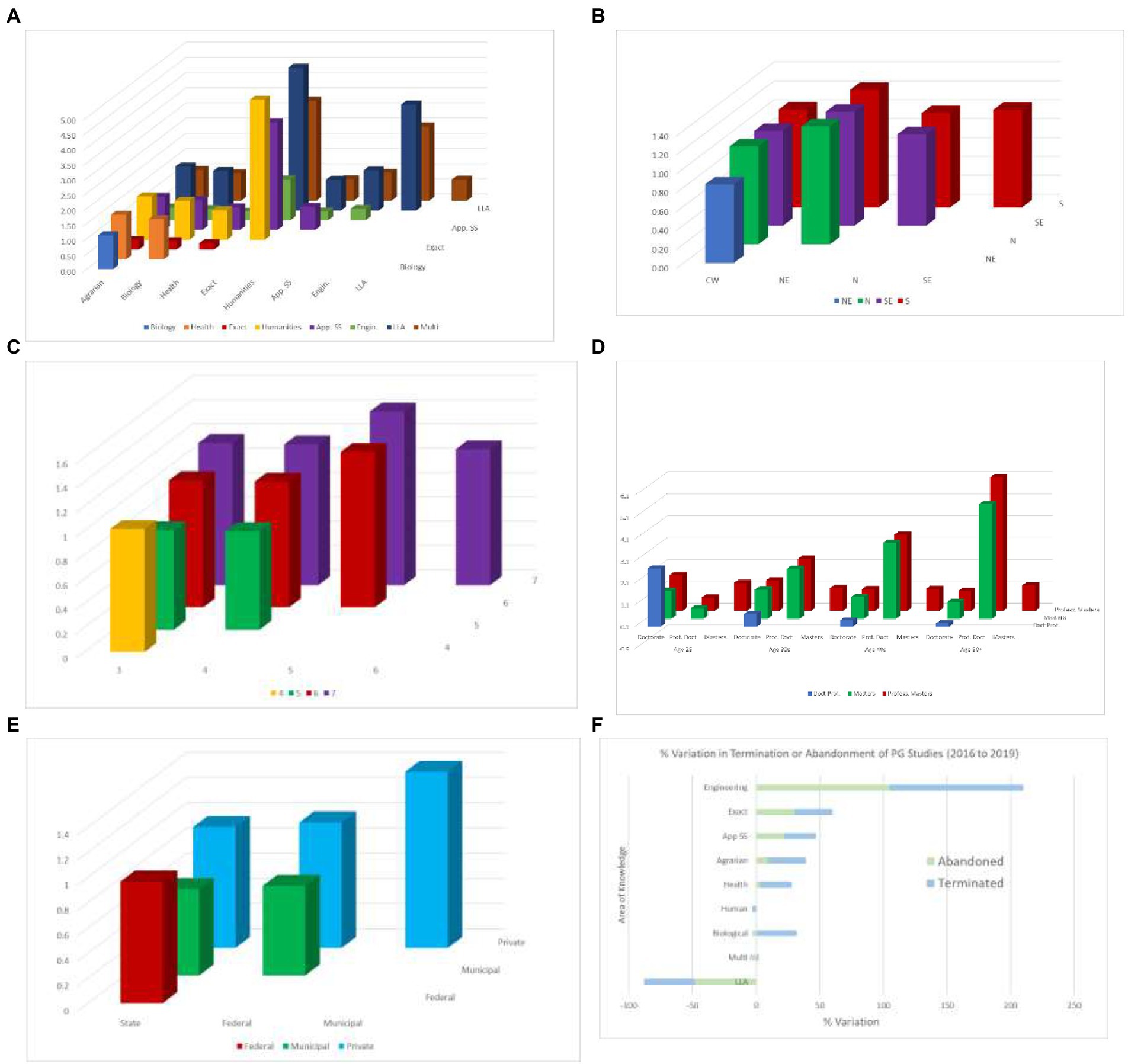
Figure 4. Odds ratios (An odds ratio of 1 means no difference between the items evaluated within the same graph.) for program abandonment and graduation by (A) area of knowledge, (B) region, (C) type of program, (D) age of the student, (E) type of institution, and (F) % change from 2016 to 2019.
The largest increase in the number of students per professor was in the multidisciplinary area (Figure 3A), grade 3 and 4 programs (Figure 3B), as well as private HEIs (Figure 3C) in the North and Northeast regions (Figure 3D). In terms of changes, the areas of Applied Social Sciences, Humanities, and Engineering had a greater change in the number of students per professor (Figure 3E).
Dropouts and graduates are higher in exact and engineering areas (Figure 4), but the reasons for this pattern are not clear. Older students (Figure 4D) are also more prone to not finish their postgraduate studies.
The financing of postgraduate education also needs to be examined (Figure 5). As can be seen, a large portion of the projects, especially in the Social Science and Humanities, either have no financing or have just scholarships, mainly from Capes. Over the last 10 years, the proportion has increased between 40 and 60%. Social Sciences and Humanities have the lowest financing independent of the region (Figure 5). The Northern region has the lowest percentage of projects without any type of funding, especially in the life sciences. In terms of lecturer mobility, 5,541 in 132,110 were seen to move between regions from 2004 to 2020. Most of this movement seems to be from the North and Northeast towards the South and Southeast (mainly São Paulo; Supplementary Video 1). This affects the ability of HEIs in these less-developed regions to maintain postgraduate studies as lecturers prefer institutions with more resources or higher prestige.
Job expectations vary according to the type of program. A higher proportion of professional master’s students look for jobs in the industry compared with those in academic programs (Supplementary Table 1). Nevertheless, 30% of students at all levels did not meet their expectations, maybe because of insecurities about future job prospects. In all categories, the expectation after postgraduate studies is to work in research or teaching.
Looking at the possible effects of the implementation of these programs and their regional impact and taking into consideration that almost all research (at least 90%) in Brazil is carried out in postgraduate programs, we looked at publication records by state in the Web of Science. The North and Northeast regions (Figure 6A) had the highest growth in the number of documents on the Web of Science (2011 to 2020), except for Roraima, while for the impact factor, the highest growth was in Rio Grande do Norte and Amapá. While Amapá grew in the number of documents and impact, the growth of Tocantins and Acre was accompanied by a worsening in impact. Moreover, Tocantins, Acre, Paraíba, Maranhão, Piauí, and Rio de Janeiro states saw a worsening of the impact factor (Figure 6B). In general, the percentage of documents published in international collaboration grew in the period, except for the state of Tocantins. Of note, the highest international collaboration was observed in Sergipe, Piauí, Mato Grosso, Acre, Mato Grosso do Sul, and Roraima (Figure 6D). Once again, the states of the North and Northeast regions showed more significant growth in the percentage of corresponding authors in the states, but with little change during the period in other regions (Figure 6C).

Figure 6. Percentage of changes in indicators (A Number of Documents, B Impact Factor, C % of corresponding authors, and D % documents in international collaboration) of the Web of Science (2011 to 2020; value <100 indicates a lower index in 2020 than in 2011).
Replies to the postgraduate deans’ questionnaire
A total of 127 deans responded to the questionnaire, representing approximately 67% of the students enrolled. Federal universities had the highest percentage of response (73%), and private universities had the lowest but not significantly different from federal education institutes (32%) and federal research institutes (31%). The Central-West region had the highest response percentage (60%), with 100% of federal universities; followed by the South region with 55% of responses and 82% of federal universities; and the Southeast region with 47% of responses and 74% of federal universities. Responses represented 71% of overall academic doctoral students and 68% of academic master’s students in the postgraduate system in Brazil. The representation of students in professional masters and doctorates was lower.
Most initiatives for creating new postgraduate courses are from institutional directives or the lecturers themselves (Figure 7). Only the Northern region believed that the system should continue expanding as before (Figure 8A), followed by the Central West (50%), and Southeast (38%) regions. The median of all regions was 39%, supporting the continued expansion of the system. In the country, no specific sector supported continued expansion, but expectations were higher among private HEIs (Figure 8B). Logistic (Figure 8C) and Correspondence (Figure 8D) analyses indicated that deans of smaller and newer institutions, especially in the North and Central-west still think expansion should continue as before (Figure 8C).
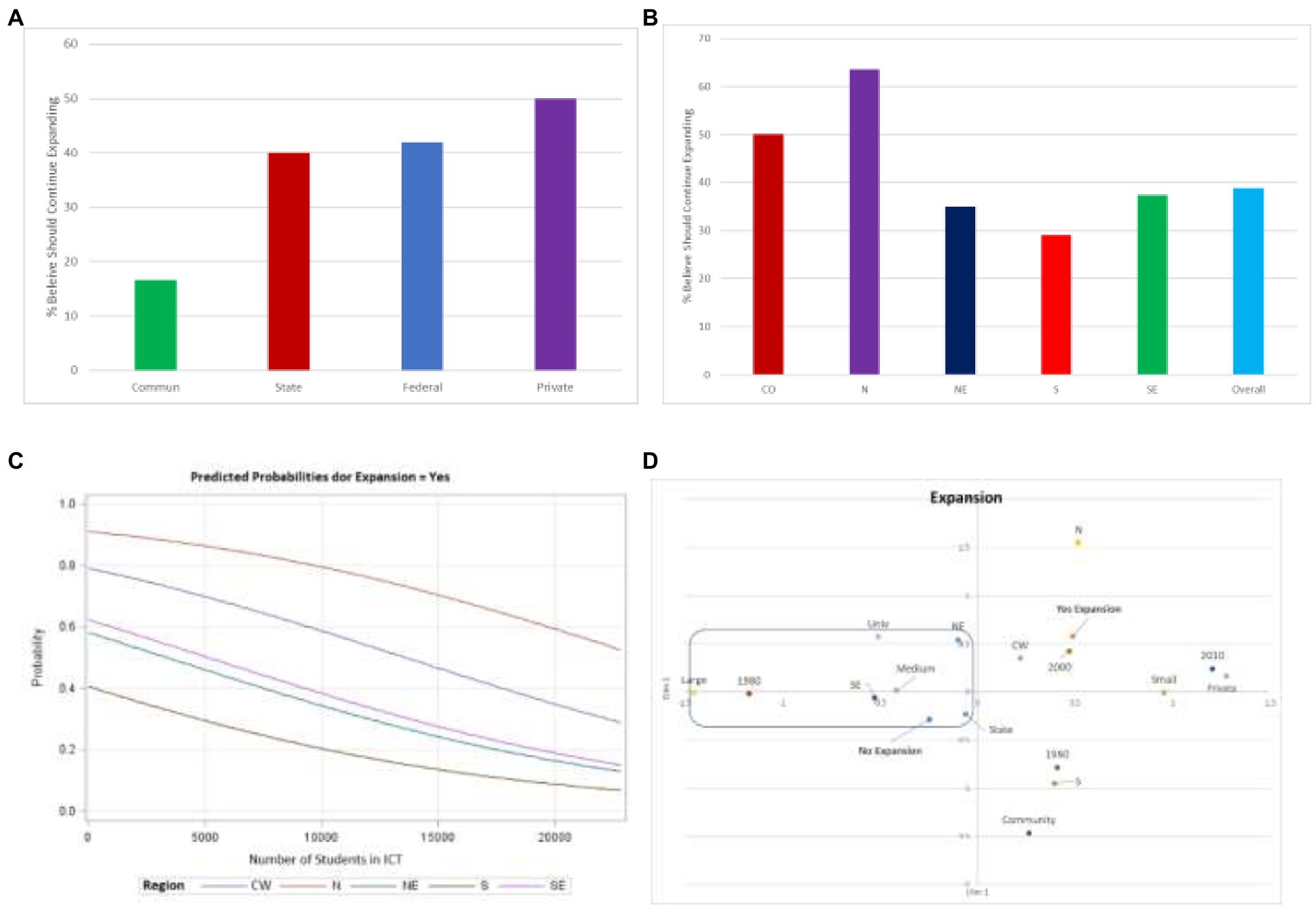
Figure 8. Postgraduate deans´ opinions on system expansion depending on (A) Legal status, (B) Region, (C) Logistic regression on the number of students, and (D) Correspondence analysis.
Few HEIs claim that the interests of society or state-of-the-art research should be the reason for creating new programs (Figure 9). When they suggest expansion, they believe it should happen in new areas of knowledge and for doctorates with national and international cooperation. Smaller and newer HEIs believe that expansion should remain as it is, while private HEIs believe that they should have postgraduate courses at a distance, with multiple terminals, or decrease due to lack of demand or supply conditions. The master’s and doctoral programs should continue to be sequential, but the network offer should grow. The HEIs in the Northern region believe that the master’s degree is to correct undergraduate flaws with subjects in the doctorate and that students cannot be research assistants. On the other hand, the HEIs in the South and Central-west regions and the ones in the community believe that a master’s degree should develop professional skills. In contrast, the larger HEIs with older postgraduate degrees in all regions, especially in the Southeast region, believe that a direct doctorate should be implemented for specific programs. The reasons for creating new programs (Figure 9C) include: (a) following the institution’s general guidelines for private and community HEIs; (b) fulfilling the lecturers’ wishes for constant expansion to state (North, Northeast, and Central-west regions) as well as to medium-sized state universities; and (c) having a state of the art research in the interest of the society in the case of the largest and oldest HEIs in the Southeast region.
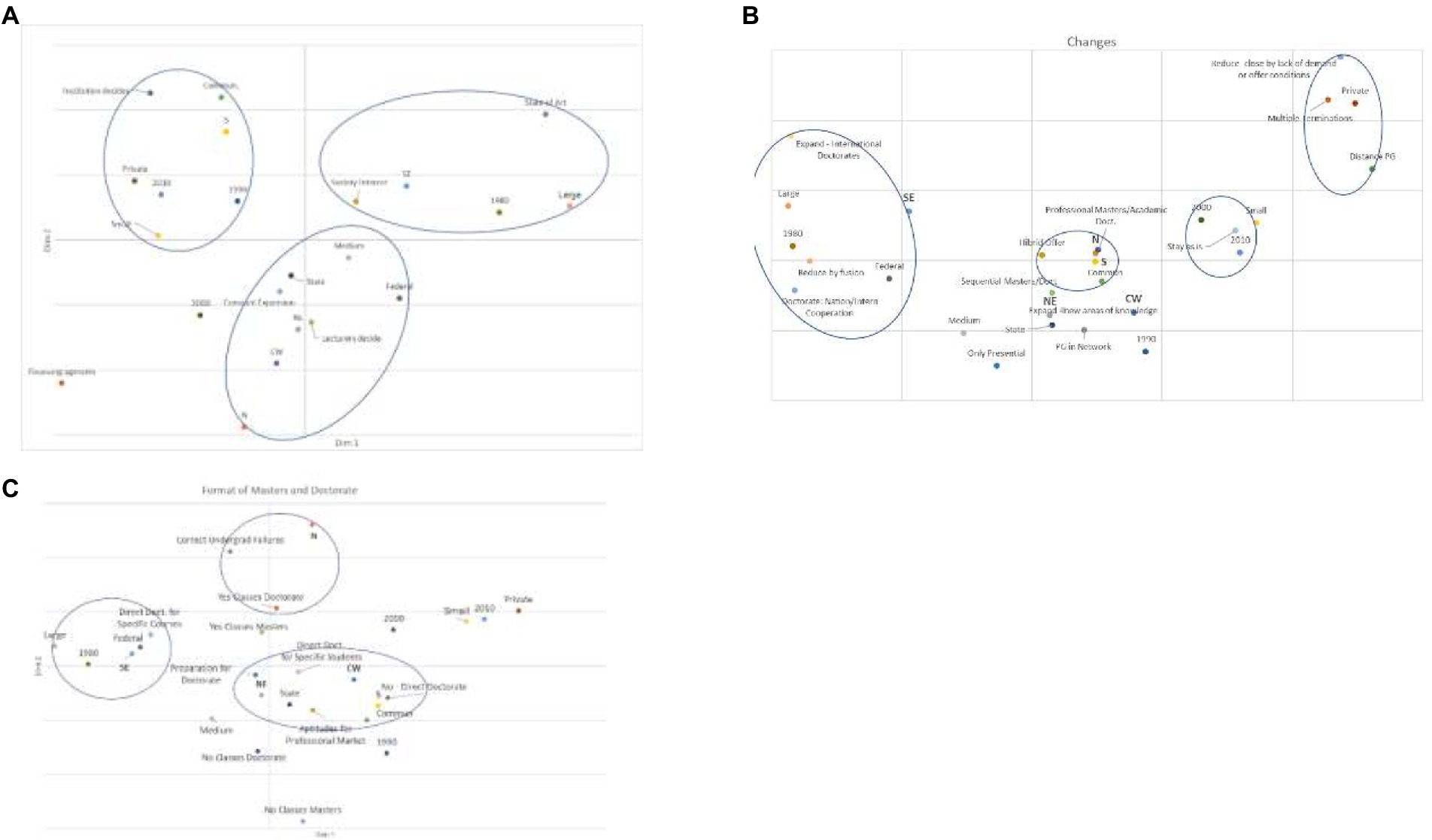
Figure 9. Reasons for creating new programs (A) the need for expansion, (B) the types of programs, and (C) the form of postgraduate courses.
Discussion
Continued expansion of the Brazilian postgraduate system needs to take into account several factors including the demand for the program, regionalization, demand for local research and societal needs, the quality of the programs being created which varies in accordance with the program proposal (McManus et al., 2022), the means of funding high-quality science, national and regional priorities, and the vacancies existing in programs with high grades. It cannot be based on the desire of university professors. Solutions such as the creation of networks between established postgraduate programs in developed regions and qualified professors in developing regions may not only reduce quality biases but also help to fill vacancies in more developed regions. This requires negotiation on an institutional scale as funding for public universities is based, in part, on the number of postgraduate programs and students, while private institutions require a minimum number of postgraduate programs to be called a “university.” The growth of the postgraduate system, therefore, has implications beyond the production of knowledge and development of postgraduate students.
Brazil has several different typologies and demands for postgraduate education (Schwartzman, 2022). These include research, professional qualification, regional, national and international development, and teacher training, among others (Supplementary Table 1). These demands should be taken into account when discussing the continued expansion of the system. McManus et al. (2022) showed that the evaluation of programs tends to be homogenous nationwide, and, as such, ignores the different proposals for which the programs were created (for example the lack of differentiation between the so-called professional and academic programs; Santos et al., 2019).
Recent expansion in the number and quality of programs has been seen in less developed regions (Figure 1) of the country (mainly the North and Central West Regions). Given the distribution of students in less developed regions in programs with higher grades (CW 7.53%; NE 19.27%, N 5.48%, SE 47.27%, and S 20.45%), one strategy could be integrating the initiative of expansion of the postgraduate system into forming national and international networks rather than creating new programs. The recognition of inter-and intra-regional inequalities in Brazil has motivated actions and policies aimed at expanding the conditions of support for existing programs and creating new programs through the granting of scholarships and funding resources. These policies and programs are based on the understanding that the creation and maintenance of graduate programs are the natural way to take advantage of the value provided by these Higher Education Institutions (HEIs) and the consequent process of institutionalizing research to meet the interests of society.
Major growth in the private sector at the undergraduate level (Noleto and de Oliveira, 2019) is starting to reflect at the postgraduate level, with an increase in 80% of lecturers in postgraduate programs in these HEIs since 2010, compared to 15% in community HEIs, 35% in State HEIs, and 50% in Federal HEIs. Although these private HEIs are paid for by students, there is still growth when compared to public HEIs which are free. The reasons for this expansion (mainly in Social Sciences and Humanities) need to be studied but it may be related to a higher percentage of night-time and weekend classes for working professionals looking for an additional postgraduate qualification (Schwartzman et al., 2021) but with less rigid requirements for entering the programs which tend to have lower grades (Table 2). According to Schwartzman et al. (2021), stricto sensu, postgraduate programs in Brazil are not seen as advanced initial training for those who are starting their career as the mean age for attaining a master’s is 32 years, and a doctorate is 37 years. This has important implications for the development of the country. The need for regional development (Tischer and Turnes, 2023) boosts the expansion of postgraduate programs, but the recent expansion of these programs (Figure 1), especially those based on research and formation of researchers, needs to be consolidated with an increase in quality (Trevisol et al., 2020). While most studies show that the expansion of campuses in the interior of the country has a positive effect on regional development (Freitas and Alves, 2021). Ferreira et al. (2021) also show that a high percentage of alumni with better education tend to leave the region looking for better job opportunities, showing the need for policies that maintain expansion in the region.
The national distribution of programs (Supplementary Figure 2), taking into account population and graduate students, shows that the issue of expansion can no longer focus exclusively on the growth in the number of programs to combat regional imbalances. Expansion needs to take into account the demand for the program itself. Postgraduate education requires a base of people with completed higher education degrees, students and professors, and resources to maintain the programs. The theme of regional imbalances has reflected the lack of objective perception about the conditions of postgraduate development in emerging regions. It is necessary to clearly explain the references that indicate real needs and establish consequent goals in the fight against these inequalities. Moreover, the maps show acute situations of low representation of graduate studies in the Northern region. This region, however, is not homogeneous in its needs and potential.
There is still a concern about quality. There is a growing perception that other ways to achieve more effective and productive integration of qualified staff from emerging HEIs into the National Postgraduate System (SNPG) exist. These may include the formation of networks with established courses in other regions. This may be interesting for all involved, as looking at the number of students per course and per lecturer (Table 3), there is a move away from courses with higher scores in the South and Southwest towards those with lower scores, especially in the North and Northeast. This tendency may be due to the availability of courses closer to home, the lack of viable scholarships, or interest in courses that deal with more locally relevant subjects. This is in line with Adefulu et al. (2020), who showed factors such as the desire to obtain a postgraduate degree, the university facilities and programs, its geographical location, and the influence of stakeholders such as family and friends as important determinants. Some differences were seen in the Humanities in the central-west and north where there tended to be growth overall. There was also growth in Multidisciplinary sciences in the northeast. Here we see a contradiction with Aitken et al. (2019) where although the location was important, so was the reputation of the degree-awarding institution. In Brazil, growth is seen in programs with lower grades. The increase in the quality of programs in the north and north-eastern regions was numerical rather than in percentage (Figure 1) and McManus et al. (2022) showed that programs in these regions take relatively longer to increase their quality in grade compared to the South and Southeast.
The higher dropout rates in exact and engineering areas (Figure 3) are worrying, but the reasons for this pattern are not clear. They may be linked to the reasons given above. According to Gama (2019), the average dropout and dismissal rates are 12.4% for the master’s degree and 11.6% for the doctorate, reaching 19.0 and 18.2%, respectively, taking into account students who leave the system without registration. There was a greater dropout rate (Figure 3) in older students, private HEIs, and lower-grade programs. In terms of program grade (Figure 3), there is a lower dropout rate in private HEIs compared to community HEIs and in a large percentage of federal HEIs with an average grade of <4. The reasons for dropping out are not clear, requiring further study, but they may be related to the institutional context (Lee, 2009), the advisors (Can et al., 2016), the graduate students themselves, the value of the scholarship (Geraghty and Oliver, 2018), or the need to maintain full-time employment (Leijen et al., 2016).
Wakeling and Laurison (2017) pointed out that degree classification, area of knowledge, age, gender, ethnicity and national origin in the UK, and previous gains in terms of equal accessibility to first degrees are at risk from postgraduate expansion. In Taiwan, Chan and Lin (2015) also argue that intensified competition for employment caused by the increased number of college graduates has incurred extra monetary costs and uncertain wage prospects at the individual level. Rongfei (2021) alerts that the employment situation of postgraduate students is becoming more serious, and the problems of unemployment are becoming more prominent. The authors argue that this is not conducive to the development of the national government, society, postgraduate training units, and graduate students themselves. Disadvantaged students might suffer the most from massification in light of increased financial investments and lower rates of return to higher education. Current scholarships from federal agencies in Brazil (December 2022) are R$1500 (Brazilian Reais or about USD280,00) per month for master’s students and R$2200 for a doctorate (about USD 400), although some individual states have increased these values recently. The latter represent a small proportion of the total number of scholarships. Federal scholarship values have not changed since 2013, compared with inflation of approximately 60% in this period. The regions that are losing students (Table 2) are those with the highest costs of living and other important related factors. Older students may have families to support (Goldrick-Rab et al., 2018), or students from other regions may feel stressed due to social position (Grady et al., 2014), race, or discrimination based on skin color (Truong et al., 2016), among others.
According to Wakeling (2010), there is very little research about the background of postgraduate students, how they fund their studies, what motivates them, and specifically whether access to postgraduate study can be considered unequal. As seen here, a large proportion of postgraduate projects in Brazil, in all areas, are without any type of financing or only with scholarships. The source of financing varied according to the area of knowledge and region of the country. As seen also by Rautiainen and Vallimies-Patomäki (2016), postgraduate financing can come from many sources such as the government, employer, or a combination of different financiers.
For a sustainable and continued expansion of the postgraduate system in Brazil, there has to be a supply of available graduate students with suitably qualified professors, adequate infrastructure and financing, political support, and a demand for the knowledge produced. Of the projects registered in the postgraduate (Sucupira) database in 2020 that had some form of financing, 2017 had foreign financing, 31.3% had some form of financing from the National Council for Scientific and Technological Development (CNPq), 21.8% from CAPES, and 11.8% from state research foundations. The universities and institutes themselves financed around 10% of the projects and 1.6% from federal, state, and municipal governments.
It is important to point out that although the federal HEIs have the largest number of programs and students, only around 45% of their professors work in postgraduate studies, while almost 100% work in undergraduate courses. The accumulated and simultaneous demands for action to solve problems and increase their insertion in basic education, graduation, innovation, internationalization, interdisciplinarity, and administration have created an overload for those professors linked to postgraduate studies, which, however, has not yet compromised their research performance. Diniz-Filho et al. (2016) noted that a high postgraduate teaching load can encourage scientific production, but the low scientific production can hardly be attributed to a high undergraduate teaching load. The authors showed that less productive researchers are using unfunded (i.e., non-peer-reviewed) research projects to justify their salaries but without concrete results. As the total number of research projects (whether funded or not) has been widely used in Brazil as part of the allocation of resources to universities by the Ministry of Education, this fact has important implications for the review of this misleading policy. This policy of investing in scientific research in a non-competitive and complacent environment can have negative implications as pointed out by Abramo and D’Angelo (2011). Castro et al. (2019) found that available financial resources were the principal factor determining the societal impact of research projects in Brazil, mainly from the ability of the research leaders to generate and maintain laboratory structures with minimum bureaucracy and not necessarily the value of resources available.
According to Han et al. (2014), the professor-student relationship is essential for the quality of postgraduate education. Indeed, the data here for Brazil shows a reduction in students per lecturer in higher quality courses in the South and Southeast, and a movement away from Life and Exact Sciences to the Social Sciences. This may also be a reflection of the expansion of undergraduate education to only a few limited areas. According to Balbachevsky et al. (2019), over 61% of all undergraduate enrolments are concentrated in Business, Social Sciences, Law, and Education. According to Jansen and Walters (2022), you cannot accelerate growth in the output of doctoral graduates when there is a weak pipeline from a dysfunctional school system. The pressure to increase the number of doctorates to acquire more funding, ranking, and throughput comes at a high cost for the quality of the graduates being produced. According to the authors, this is acerbated by pressure to redress social injustices from the country’s colonial past reflected in the unequal outcomes of doctorates by race and gender.
In China, postgraduate expansion has brought a series of problems but mainly an excessive focus on postgraduate academic education and ignoring professional postgraduate training (Qiao and Lei, 2015). This is also seen in Brazil whereby only 916 of the 7,025 postgraduate courses are professional2. Tortorella et al. (2022) showed that postgraduate programs lack emphasis on creativity, entrepreneurial thinking, leadership, adaptability, and flexibility possibly due to how they are evaluated (McManus et al., 2022). The only numerical goal in the last national plan (CAPES, 2022) was for the expansion of the system. National plans in other countries for postgraduate studies often distinguish between objectives referring to system expansion and those reflecting particular national priorities. This was seen in Taiwan (Chan and Lin, 2015) where expansion was to meet the demands of economic transformation as well as cultural expectations.
Other problems here come from the non-continuity of projects and policies in the definition of priority, where the meaning of everything as a priority means that nothing is a priority (McManus et al., 2021). The multiplication of the number of master’s and doctoral degrees, in general, is the primary goal of the last PNPG (2011–2020). The Social Demand program (granting of scholarships by quotas to the postgraduate programs) is the primary financial support for training master’s and doctorate students. Specific programs for awarding scholarships and funding would serve specific strategic objectives. In the first case, policies have open and diffuse objectives. The second case is about inducing system responses to specific objectives.
The high degree of funding in the Northern region may seem paradoxical, but over the years many programs have been established to support research and postgraduate studies in this region (for example CAPES PDPG Amazônia Legal; Programa Pró-Amazônia; Fulbright Amazônia) as well as several calls maintaining that 30% of the financing will go to projects in the N, NE, and CW regions. These states (except Roraima) also have local financing agencies. This has meant that several postgraduate deans, mainly in the northern region, say that the number of scholarships is not a problem for the postgraduate programs. The value of these was commented on earlier, although some states have a higher value, such as São Paulo, Pernambuco, Goiás, Espírito Santo, Alagoas, Rio de Janeiro, and Santa Catarina, among others.
In general, the expansion of the number of programs should not be the priority of the new PNPG as the data show that it is possible to increase the productivity of the system by exploiting the installed capacity for training human resources and producing knowledge from the strengthening of regional and national networks. It is important to know how to deal with the high dropout rates and the aging tendency of the teaching staff and focus on the quality of the result delivered to society. The network postgraduate proposal points to three directions according to the deans: (a) expansion of national and international cooperation between programs (McManus et al., 2020; McManus and Baeta Neves, 2021b); (b) initiatives originating in a network with the help of professors from different institutions and sharing of infrastructure to support a program (there are already successful examples such as de Andrade et al., 2022) and; (c) greater integration of professors from emerging HEIs in existing consolidated programs with an appreciation of the potential for expanding training on a national scale.
The answers to the questionnaire sent to the FOPROP members allow us to identify that the idea of expansion should be treated differently depending on several factors, for example, the age of the postgraduate program in the HEI, the region in which the HEI is located, and the legal status of the HEI. Overall, the case for the expansion itself, at least in current terms, is not very strong (less than 40% of the total HEIs that responded to the questionnaire). The responses of the deans emphasize that new programs must respond mainly to the demands of society, the priorities of the agencies, and the initiative of the professors according to institutional guidelines. There is therefore a broad understanding that it is no longer a question of creating programs to primarily meet the needs of professors in terms of their particular projects of institutional insertion or professional development. The limitations of the postgraduate system raised by Souza et al. (2020) should be taken into account, as expansion without quality can damage the development of the country as a whole.
Concluding remarks
Graduate students are the most important source of future contributions to the development of knowledge. With appropriate supervision of postgraduate research students, research capacity development should be acquired as characterized by confidence, willingness to share research knowledge with others, lifelong learning skills, commitment, and independence to pursue a research career. Achieving these goals require commitment from graduate students and supervisors, and expectations must be clear from the start and continue throughout the process. There is always a risk of mismatches between supervisory styles, student needs, and program requirements, and the problem can be compounded by funding structures for public higher education institutions. David and Hill (2020) also point out that postgraduate learners prefer postgraduate curricula to be challenging, current, offered in a contested mode, and career and profession-focused.
Brazil should also not close its eyes to the changing demands for PhDs worldwide (Nature Editorial, 2023) taking into account the organization and funding of the system. According to Nerad et al. (2022), in numerical terms, Brazil has more PhD graduates per year than Japan and South Korea.
Everything indicates that the new stage of postgraduate development must be guided by CAPES policies that focus on the necessary responses to face challenges and prioritize problems for scientific and technological development and the country in general. The expansion of the national postgraduate system is no longer an objective and should be guided by national priorities. Thus, the system’s growth must occur in those fields that prove to be strategic for achieving national or regional goals, thinking globally and acting locally. New (and older) programs must meet the needs of strategic priorities.
Data availability statement
The raw data supporting the conclusions of this article will be made available by the authors, without undue reservation.
Ethics statement
Ethical review and approval were not required for the study on human participants in accordance with the local legislation and institutional requirements. Written informed consent for participation was not required for this study in accordance with the national legislation and the institutional requirements.
Author contributions
CM, AN, and CC: conception and review. CM, AN, AGSF, and JF: data collection, analysis, and writing. DF, MF, SB, IM, BD, EC, JA, MdF, JG, MC, RS, and MN: discussion groups, preliminary reports, and reviewing and correction. All authors contributed to the article and approved the submitted version.
Funding
The data were available from CAPES as well as access to the “Portal de Períodicos” gateway for literature review.
Acknowledgments
We thank Capes for funding, Leonardo Tinoco Rosa – UFRJ, Cristiano Marcelo Espinola Carvalho – UCDB, Lucilene Zanateli Pereira – USP, Charles Morphy Dias dos Santos – UFABC. AGSF acknowledges funding from Fundação Cearense de Apoio ao Desenvolvimento Científico e Tecnológico (FUNCAP) through the Cientista Chefe program.
Conflict of interest
The authors declare that the research was conducted in the absence of any commercial or financial relationships that could be construed as a potential conflict of interest.
Publisher’s note
All claims expressed in this article are solely those of the authors and do not necessarily represent those of their affiliated organizations, or those of the publisher, the editors and the reviewers. Any product that may be evaluated in this article, or claim that may be made by its manufacturer, is not guaranteed or endorsed by the publisher.
Supplementary material
The Supplementary material for this article can be found online at: https://www.frontiersin.org/articles/10.3389/feduc.2023.987200/full#supplementary-material
Supplementary Video S1 | Movement of Lecturers in Brazil (2004 to 2020). Video shows moves from the North to Northeast and then to South-eastern states (mainly São Paulo). Video was from Sucupira data and created in Excel®.
Footnotes
1. ^https://sucupira.capes.gov.br/sucupira/
2. ^https://sucupira.capes.gov.br/sucupira/public/consultas/coleta/programa/quantitativos/quantitativoRegiao.jsf;jsessionid=IpC19tcuSCVdbQWNHKsjYjWE.sucupira-213
References
Abramo, G., and D’Angelo, C. A. (2011). National-scale research performance assessment at the individual level. Scientometrics 86, 347–364. doi: 10.1007/s11192-010-0297-2
Adefulu, A., Farinloye, T., and Mogaji, E. (2020). “Factors influencing postgraduate students’ university choice in Nigeria” in Higher education Marketing in Africa. eds. E. Mogaji, F. Maringe, and R. Ebo Hinson (Cham: Palgrave Macmillan)
Aitken, G., Jones, D., Fawns, T., Sutherland, D., and Henderson, S. (2019). Using Bourdieu to explore graduate attributes in two online Master’s programmes. Advan. Health Sci. Educ. 24, 559–576. doi: 10.1007/s10459-019-09885-6
Akalu, G. A. (2014). Higher education in Ethiopia: expansion, quality assurance and institutional autonomy. High. Educ. Q. 68, 394–415. doi: 10.1111/hequ.12036
Almeida, A. N. D., Neres, I. V., Nunes, A., and Souza Júnior, C. V. N. D. (2020). Effectiveness of public university expansion in Brazil: comparison between the situation of graduated and dropout students. Ensaio: Avaliação e Políticas Públicas em Educação 28, 457–479. doi: 10.1590/S0104-40362019002701864
Balbachevsky, E., Sampaio, H., and de Andrade, C. Y. (2019). Expanding access to higher education and its (limited) consequences for social inclusion: the Brazilian experience. Social Inclusion 7, 7–17. doi: 10.17645/si.v7i1.1672
Bicalho de Souza, D., Grijó Pitangui, C., Pereira de Assis, L., Vivas Andrade, A., and Fonte Boa Carvalho, H. (2021). Estudo sobre a evasão de alunos dos cursos de pós-Graduação (lato sensu) da modalidade ead de uma Instituição de ensino privada utilizando mineração de dados. Congresos CLABES. Access in: https://revistas.utp.ac.pa/index.php/clabes/article/view/3347
Can, E., Richter, F., Valchanova, R., and Dewey, M. (2016). Supervisors' perspective on medical thesis projects and dropout rates: survey among thesis supervisors at a large German university hospital. BMJ Open 6:e012726. doi: 10.1136/bmjopen-2016-012726
CAPES. (2022). Sumário Executivo PNPG 2011–2020. Available at: https://www.gov.br/capes/pt-br/acesso-a-informacao/institucional/plano-nacional-de-pos-graduacao-pnpg/plano-nacional-de-pos-graduacao-pnpg-2011-2020
Carpenter, J. (2019). Your parents financial advice is (kind of) wrong. Wall Street J. September 13, 2019. Accessed November 2021, 2020. https://www.wsj.com/articles/your-parents-financial-advice-is-kind-of-wrong-11568367000
Castro, I. J., Nagano, M. S., and Ribeiro, S. X. (2019). ‘Elements that influence knowledge sharing in the university-industry-government collaboration: case studies in Brazil.’ Revista de Gestão. 26. Available at: https://www.emerald.com/insight/content/doi/10.1108/REGE-04-2018-0061/full/html
Chan, S. J., and Lin, L. W. (2015). Massification of higher education in Taiwan: shifting pressure from admission to employment. High Educ. Pol. 28, 17–33. doi: 10.1057/hep.2014.33
Cirani, C. B. S., Campanario, M. A., and Silva, H. H. M. (2015). A evolução do ensino da pós-graduação senso estrito no Brasil: análise exploratória e proposições para pesquisa. Avaliação: Revista da Avaliação da Educação Superior 20, 163–187.
Colombo, D. G., and de Castro Garcia, R., (2021). O Papel das Relações Acadêmicas de Ex-Alunos de Pós-Graduação na Colaboração Universidade-Empresa. V ENEI, Encontro Nacional de Economia Industrial e Inovação. Available at: http://pdf.blucher.com.br.s3-sa-east-1.amazonaws.com/engineeringproceedings/v-enei/610.pdf
Costa, D. D. M. (2022). Higher education and the principles of access, quality and accountability: Brazil × Canada panorama. Qual. Assur. Educ. 30, 319–335. doi: 10.1108/QAE-08-2021-0122
David, S. A., and Hill, C. (2020). Curriculum innovation for postgraduate programs: perspectives of postgraduate learners. Int. J. Innov. Learn. 28, 297–316. doi: 10.1504/IJIL.2020.109838
de Andrade, E. A., Alfieri, F. M., Bertolini, S. M., Garcia, L. F., Bunherotti, M. A., Pina, M. G., et al. (2022). “Sharing paths and converging learning: a consortium of Brazilian health promotion graduate programs” in International handbook of teaching and learning in health promotion. eds. A. Marco and G. G. Ana Claudia Camargo (Cham: Springer), 709–724.
Diniz-Filho, J. A. F., Fioravanti, M. C. S., Bini, L. M., and Rangel, T. F. (2016). Drivers of academic performance in a Brazilian university under a government-restructuring program. J. Informet. 10, 151–161. doi: 10.1016/j.joi.2015.12.004
Fatemi, G., and Saito, E. (2019). Unintentional plagiarism and academic integrity: the challenges and needs of postgraduate international students in Australia. J. Furth. High. Educ. 44, 1305–1319. doi: 10.1080/0309877X.2019.1683521
Ferreira, H., Oliveira, E., Braga, R., Oliveira, M., and Oliveira, C. (2021). Um estudo do impacto de egressos no desenvolvimento regional como reflexo da interiorizaçao do ensino superior. In Anais do XXIX Workshop sobre Educação em Computação (pp. 428–437). SBC.
Freitas, C. C. G., and Alves, L. D. S. F. (2021). Uma revisão da interiorização do ensino superior e deslocamentos populacionais no semiárido. Latin American Journal of Business Management 12, 167–174.
Gama, D. (2019). A trajetória dos estudantes de pós-graduação stricto sensu no Brasil. Cadernos de Estudos e Pesquisas em Políticas Educacionais 3:40. doi: 10.24109/9786558010074.ceppe.v3a6
Geraghty, S., and Oliver, K. (2018). In the shadow of the ivory tower: experiences of midwives and nurses undertaking PhDs. Nurse Educ. Today 65, 36–40. doi: 10.1016/j.nedt.2018.02.017
Goldrick-Rab, S., Richardson, J., Schneider, J., Hernandez, A., and Cady, C. (2018). ‘Still hungry and homeless in college ’. Madison: Wisconsin HOPE Lab.
Grady, R. K., La Touche, R., Oslawski-Lopez, J., Powers, A., and Simacek, K. (2014). Betwixt and between: the social position and stress experiences of graduate students. Teach. Sociol. 42, 5–16. doi: 10.1177/0092055X13502182
Han, S., Li, J., Li, Z., and Zeng, Q. (2014). Study of the harmonious teacher-student relationship in the postgraduate enrollment expansion situation’. In 2014 international conference on e-education, e-business and information management (ICEEIM 2014) (pp. 193–195). Atlantis Press.
Jansen, J. D., and Walters, C. A. (2022). “The thinking doctorate and the factory model of production: cautionary tales from the south” in Towards a global Core value system in doctoral education. eds. M. Nerad, D. Bogle, U. Kohl, C. O’Carroll, C. Peters, and B. Scholz (London: UCL Press), 1–17.
Jung, J., and Lee, S. J. (2019). Exploring the factors of pursuing a master’s degree in South Korea. High. Educ. 78, 855–870. doi: 10.1007/s10734-019-00374-8
Lee, N. J. (2009). Professional doctorate supervision: exploring student and supervisor experiences. Nurse Educ. Today 29, 641–648. doi: 10.1016/j.nedt.2009.02.004
Leijen, Ä., Lepp, L., and Remmik, M. (2016). Why did I drop out? Former students’ recollections about their study process and factors related to leaving the doctoral studies. Stud. Contin. Educ. 38, 129–144. doi: 10.1080/0158037X.2015.1055463
Lu, Y. H., Qian, J. F., Chen, Y. L., Xu, L., and Yang, Z. H. (2013). Problems and countermeasures of postgraduate education quality. J. Dali University 12, 86–88.
Masayuki, M. O. R. I. K. A. W. A. (2011). ‘Postgraduate Education and Human Capital Productivity in Japan’ RIETI Discussion Paper Series 12-E-009. Available at: https://www.rieti.go.jp/jp/publications/dp/12e009.pdf
McManus, C., and Baeta Neves, A. A. (2021a). Production profiles in Brazilian science, with special attention to social sciences and humanities. Scientometrics 126, 2413–2435.
McManus, C., and Baeta Neves, A. A. (2021b). Funding research in Brazil. Scientometrics 126, 801–823. doi: 10.1007/s11192-020-03762-5
McManus, C., Baeta Neves, A. A., Maranhão, A. Q., Souza Filho, A. G., and Santana, J. M. (2020). International collaboration in Brazilian science: financing and impact. Scientometrics 125, 2745–2772. doi: 10.1007/s11192-020-03728-7
McManus, C., Baeta Neves, A. A., Souza Filho, A. G., Rosa, A. A. S., Carvalho, C. H., Freire, D. M. G., et al. (2022). Assessment of the Brazilian postgraduate evaluation system. Front. Educ. 7:1036108. doi: 10.3389/feduc.2022.1036108
McManus, C., Neves, A. A. B., Diniz Filho, J. A., Maranhao, A. Q., and Souza Filho, A. G. (2021). Profiles not metrics: the case of Brazilian universities. An. Acad. Bras. Cienc. 93:e20200261. doi: 10.1590/0001-3765202120200261
Nature Editorial (2023). PhD training is no longer fit for purpose — it needs reform now. Nature 613:414. doi: 10.1038/d41586-023-00084-3
Nerad, M., Bogle, D., Kohl, U., O’Carroll, C., Peters, C., and Scholz, B. (2022). Towards a global Core value system in doctoral education. (London: UCL Press), 290.
Noleto, S. D. O. B., and de Oliveira, J. F. (2019). Estado, Educação Superior e universidade no Brasil: processos de reconfiguração em tempos de reestruturação do capital. Revista Brasileira de Política e Administração da Educação 35:427. doi: 10.21573/vol35n22019.95411
Paula, C. H. D., and Almeida, F. M. D. (2020). Reuni program and performance of Brazilian IFES. Ensaio: Avaliação e Políticas Públicas em Educação 28, 1054–1075. doi: 10.1590/S0104-40362020002801869
Qiao, C. H. E. N., and Lei, D. E. N. G. (2015). Chinese postgraduate education reform: transition from Academical to professional. Cross-Cultural Commun. 11, 65–69. doi: 10.3968/%25x
Rautiainen, E., and Vallimies-Patomäki, M. (2016). A review of the organization, regulation, and financing practices of postgraduate education in clinical nursing in 12 European countries. Nurse Educ. Today 36, 96–104. doi: 10.1016/j.nedt.2015.08.004
Rongfei, L. (2021). Research on postgraduate employment problems and countermeasures. Academic J. Humanities & Social Sci. 4, 66–69. doi: 10.25236/AJHSS.2021.040811
Sales, E. C. D. S. S., Rosim, D., Ferreira, V. D. R. S., and Costa, S. H. B. (2019). Program to support the plans for restructuring and expansion of the Federal Universities System in Brazil (REUNI): an analysis of its evaluation process. Avaliação: Revista da Avaliação da Educação Superior (Campinas) 24, 658–679. doi: 10.1590/s1414-40772019000300006
Santos, G. B. D., Hortale, V. A., Souza, K. M. D., and Vieira-Meyer, A. P. G. F. (2019). Similaridades e diferenças entre o Mestrado Acadêmico e o Mestrado Profissional enquanto política pública de formação no campo da Saúde Pública. Cien. Saude Colet. 24, 941–952. doi: 10.1590/1413-81232018243.30922016
Schwartzman, S. (2022). Pesquisa e Pós-Graduação no Brasil: duas faces da mesma moeda? Estudos Avançados 36, 227–254. doi: 10.1590/s0103-4014.2022.36104.011
Schwartzman, S., Silva Filho, R. L., and Coelho, R. R. (2021). Por uma tipologia do ensino superior brasileiro: teste de conceito. Estudos Avançados 35, 153–186. doi: 10.1590/s0103-4014.2021.35101.011
Souza, D. L. D., Zambalde, A. L., Mesquita, D. L., Souza, T. A. D., and Silva, N. L. C. D. (2020). The perspective of researchers on the challenges of research in Brazil. Educ. Pesqui. 46:e221628. doi: 10.1590/s1678-4634202046221628
Tian, L., Lv, Y., Ren, H., Zhao, Y., Zhou, Z., and Lin, P. (2019). ‘Discussion on postgraduate education and Management in Colleges and Universities’. In 2019 5th international conference on social science and higher education (ICSSHE 2019) (pp. 363–366). Atlantis Press.
Tischer, W., and Turnes, V. A. (2023). Interiorização da Pós-Graduação na Região Sul: dispersão Stricto Sensu e concentração da excelência. Revista Internacional de Educação Superior 9:e023045. doi: 10.20396/riesup.v9i00.8663669
Tortorella, G. L., Cauchick-Miguel, P. A., Frazzon, E. M., Fogliatto, F. S., Godinho Filho, M., and Thürer, M. (2022). Readiness of Brazilian industrial engineering postgraduate programs for industry 4.0: a knowledge dimensions assessment. Comput. Appl. Eng. Educ. doi: 10.1002/cae.22595
Trevisol, J. V., Bastiani, S. C. D., and Brasil, A. (2020). As dinâmicas da Pós-graduação em Santa Catarina: evolução e perspectivas (1969-2018). Avaliação: Revista da Avaliação da Educação Superior (Campinas) 25, 178–198. doi: 10.1590/s1414-407720200001000010
Truong, K. A., Museus, S. D., and McGuire, K. M. (2016). Vicarious racism: a qualitative analysis of experiences with secondhand racism in graduate education. Int. J. Qual. Stud. Educ. 29, 224–247. doi: 10.1080/09518398.2015.1023234
Wakeling, P. (2010). “Inequalities in postgraduate education: a comparative review” in Understanding inequalities in, through and by higher education. ed. G. Goastellec (Netherlands: BRILL), 61–74.
Wakeling, P., and Laurison, D. (2017). Are postgraduate qualifications the 'new frontier of social mobility? Br. J. Sociol. 68, 533–555. doi: 10.1111/1468-4446.12277
Keywords: demand, development, quality, quantity, regional differences
Citation: McManus C, Baeta Neves AA, Carvalho CH, Souza Filho AG, Freire DMG, Fioravanti MCS, Báo SN, de Medeiros IA, Diniz Filho JA, Diaz BL, de Carvalho ER, Audy JLN, Silva Filho MdC, Gimenez JR, Carvalho M, da Silva RR and Napimoga MH (2023) Considerations for continued expansion of the Brazilian post-graduate system. Front. Educ. 8:987200. doi: 10.3389/feduc.2023.987200
Edited by:
Ferhan Sağın, Ege University, TürkiyeReviewed by:
Aderinola Dunmade, University of Ilorin, NigeriaFreddy Marín-González, Costa University Corporation, Colombia
Copyright © 2023 McManus, Baeta Neves, Carvalho, Souza Filho, Freire, Fioravanti, Báo, de Medeiros, Diniz Filho, Diaz, Carvalho, Audy, Silva Filho, Gimenez, Carvalho, da Silva and Napimoga. This is an open-access article distributed under the terms of the Creative Commons Attribution License (CC BY). The use, distribution or reproduction in other forums is permitted, provided the original author(s) and the copyright owner(s) are credited and that the original publication in this journal is cited, in accordance with accepted academic practice. No use, distribution or reproduction is permitted which does not comply with these terms.
*Correspondence: Concepta McManus, concepta@unb.br
 Concepta McManus
Concepta McManus Abilio Afonso Baeta Neves
Abilio Afonso Baeta Neves Carlos Henrique Carvalho
Carlos Henrique Carvalho Antonio Gomes Souza Filho
Antonio Gomes Souza Filho Denise Maria Guimarães Freire
Denise Maria Guimarães Freire Maria Clorinda Soares Fioravanti
Maria Clorinda Soares Fioravanti Sônia Nair Báo
Sônia Nair Báo Isac Almeida de Medeiros
Isac Almeida de Medeiros José Alexandre Diniz Filho6
José Alexandre Diniz Filho6  Bruno Lourenço Diaz
Bruno Lourenço Diaz Marcio de Castro Silva Filho
Marcio de Castro Silva Filho Juliano Rodrigues Gimenez
Juliano Rodrigues Gimenez Marcelo Henrique Napimoga
Marcelo Henrique Napimoga